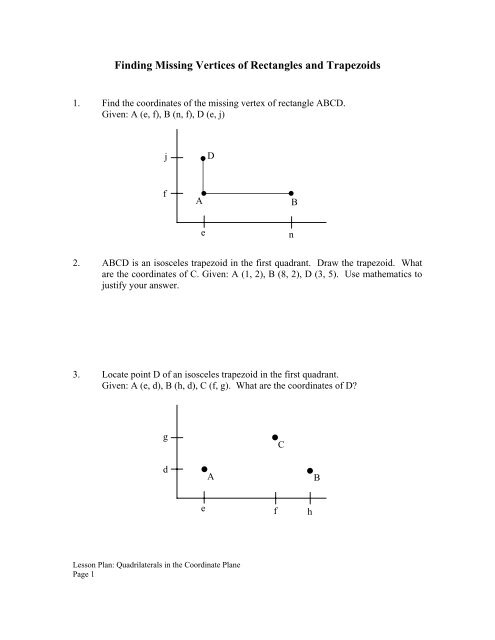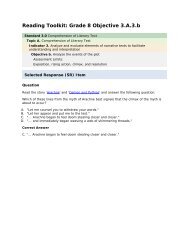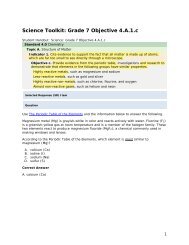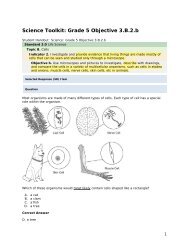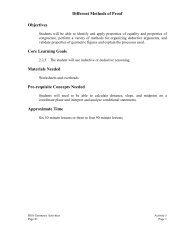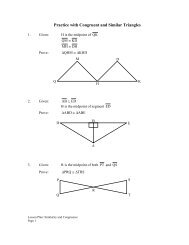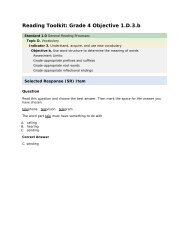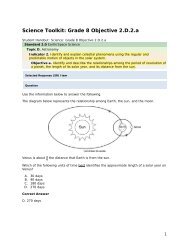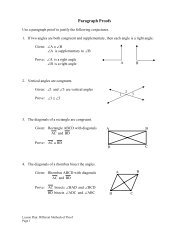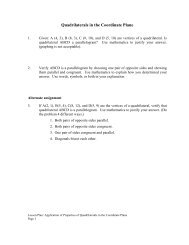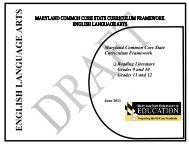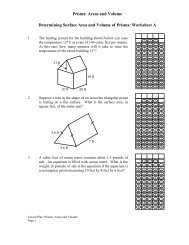Finding Missing Vertices of Rectangles and Trapezoids - mdk12
Finding Missing Vertices of Rectangles and Trapezoids - mdk12
Finding Missing Vertices of Rectangles and Trapezoids - mdk12
You also want an ePaper? Increase the reach of your titles
YUMPU automatically turns print PDFs into web optimized ePapers that Google loves.
<strong>Finding</strong> <strong>Missing</strong> <strong>Vertices</strong> <strong>of</strong> <strong>Rectangles</strong> <strong>and</strong> <strong>Trapezoids</strong><br />
1. Find the coordinates <strong>of</strong> the missing vertex <strong>of</strong> rectangle ABCD.<br />
Given: A (e, f), B (n, f), D (e, j)<br />
j D<br />
2. ABCD is an isosceles trapezoid in the first quadrant. Draw the trapezoid. What<br />
are the coordinates <strong>of</strong> C. Given: A (1, 2), B (8, 2), D (3, 5). Use mathematics to<br />
justify your answer.<br />
3. Locate point D <strong>of</strong> an isosceles trapezoid in the first quadrant.<br />
Given: A (e, d), B (h, d), C (f, g). What are the coordinates <strong>of</strong> D?<br />
Lesson Plan: Quadrilaterals in the Coordinate Plane<br />
Page 1<br />
f<br />
g<br />
d<br />
A<br />
e<br />
e<br />
A<br />
f<br />
C<br />
B<br />
n<br />
h<br />
B
<strong>Finding</strong> <strong>Missing</strong> <strong>Vertices</strong> <strong>of</strong> <strong>Rectangles</strong> <strong>and</strong> <strong>Trapezoids</strong> (Continued)<br />
Assignment<br />
Find the coordinates <strong>of</strong> the missing vertices <strong>of</strong> the rectangles:<br />
1. A (2, 3), B (10, 3), C ( ), <strong>and</strong> D (2, 8).<br />
Use mathematics to justify that ABCD is a rectangle.<br />
2. A (p, q), B (m, q), C ( ),<strong>and</strong> D (p, v).<br />
Find the coordinates <strong>of</strong> the missing vertices <strong>of</strong> the following isosceles trapezoids<br />
3. A (3, 6), B (10, 6), C( ), <strong>and</strong> D (5, 10).<br />
Use mathematics to justify that ABCD is an isosceles trapezoid.<br />
4. A (w, t), B (h, t), C ( ), <strong>and</strong> D (n, q)<br />
Lesson Plan: Quadrilaterals in the Coordinate Plane<br />
Page 2
Assignment<br />
Answers: 1. C (n, j)<br />
2. C (6, 5) Students should use the slope formula to<br />
show AB is parallel to CD (the slope <strong>of</strong> each<br />
segment is 0) <strong>and</strong> the distance formula to show AD<br />
is congruent to BC , length is 13 .) ABCD is an<br />
isosceles trapezoid by definition: a trapezoid is<br />
isosceles if the legs are congruent.<br />
3. D (e + h - f, g)<br />
Answers: 1. C (10, 8) Students can use the slope formula to<br />
show: opposite sides are parallel (slopes are: 0 <strong>and</strong><br />
undefined), then pairs <strong>of</strong> consecutive sides are<br />
perpendicular are perpendicular. ABCD is a<br />
parallelogram with right angles so ABCD is a<br />
rectangle by definition.<br />
2. C (m, v)<br />
3. (8, 10) The results <strong>of</strong> finding the slopes <strong>of</strong> the four<br />
sides: AB <strong>and</strong> CD are parallel since m = 0 for<br />
each. The slope <strong>of</strong> AD is 2 <strong>and</strong> the slope <strong>of</strong> BC is<br />
-2. Therefore AD <strong>and</strong> BC must be the non-parallel<br />
sides: legs. Using the distance formula we find the<br />
length <strong>of</strong> each leg is the same: 20 . By definition<br />
ABCD is an isosceles trapezoid because it is a<br />
quadrilateral with exactly one pair <strong>of</strong> parallel sides<br />
<strong>and</strong> the legs are congruent.<br />
4. C (h - (n - w), q)<br />
Lesson Plan: Quadrilaterals in the Coordinate Plane<br />
Page 3


